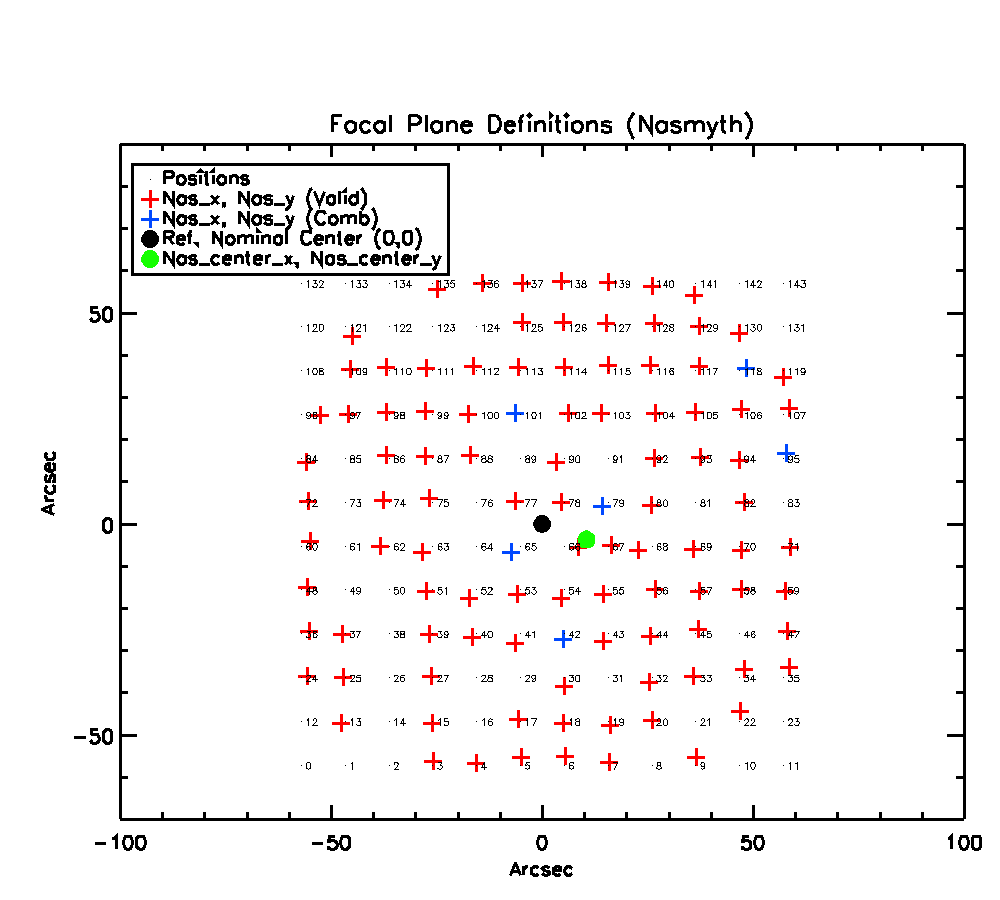NIKA run #4 (28 May - 5 June 2012)
Pixel information
Each time resonances are changed, a new OTF_geometry is made and .fits file is produced. The .fits file will contain information ordered according to grid positions and *NOT* resonance indexing. This way, the format is fixed for all changes in resonances. Positions range from 0 to 143 for ON pixels. OFF-resonance pixels are placed in fictitious positions 144 to 159.
The nominal center of the matrix will be used as reference for the pointing model. Nas_center_x and Nas_center_y are the coordinates of the center of rotation that is fit from observations. It is degenerated with global telescope pointing offset and its value will be determined by iterations.
RZ, June 1 2012: Do not understand the above 2 statements. The nominal center falls between the pixels, therefore how do you want to use it for pointings, i.e. cross scans ?
A more complete description of the .fits file and its information will be place here soon.

Detector information
COMMON FILTERS: IR-blockers at 150 K and 50 K; 13 cm-1 low-pass at 50 K; 11 cm-1 low-pass at 4 K; 10 cm-1 low-pass at 1 K.
BAND 1.25 mm (dichroic in transmission) - NICA_8e (224 pixels array, Hilbert dual-polarisation design, pixels pitch 1.6mm on both x and y <=> 0.8 Fλ), 20-25nm (IRAM film), substrate 0.18 mm, backshort 0.47-0.49 mm. Amplifier SiGe Caltech LF4 (S/N 84, IRAM batch, Vd = 1.5 V). From laboratory measurements we estimate an NET of about 2-3 mK/sqrt(Hz) per pixel at 1 Hz. Central frequency 240-250 GHz (measured with the MpI). Resonances at 1.9-2.6 GHz (about 100 resonances, at the center, within the ROACH electronics band of 275 MHz). Two almost equivalent arrays are available (small differences in film thickness and backshort). Final decision will be made just before the run.
BAND 2 mm (dichroic in reflection + 5.7 cm-1 low-pass + 3.9 cm-1 high-pass) - NICA_8c (132 pixels array, Hilbert dual-polarisation design, pixels pitch 2.3 mm on both x and y <=> 0.77 Fλ with the current optics), 20 nm (IRAM film), substrate 0.3 mm, backshort 0.7 mm. Amplifier SiGe Caltech LF4 (S/N 70, IRAM batch, Vd = 1.5 V). From laboratory measurements we estimate an NET of about 3-5 mK/sqrt(Hz) per pixel. Resonances at 1.3-1.5 GHz. Three almost equivalent arrays are available (same thickness, same backshort). One easy option is to use the same array mounted in 2011.
FOV = 2.3’ diameter for each of the arrays if fully used (rq: potential of the new optical system & cryostat = 2.8’).
MPI spectral transmission measurements (A. Monfardini, M. Calvo, FXD) of representative arrays can be found here and compared with Run#2 and #3. Maximum transmission is at 144 and 242 GHz. FWHM is 43 and 57 GHz. These are pseudo-transmission curves as they already include a nu^2 Rayleigh-Jeans weighting (the hot&cold load calibration source spectrum).
